How to Know When It’s Time to GO! 5 Tips for Removing Garden Plants
One of the most frequent gardening questions I get asked by new gardeners is:
“How do I know when it it’s time to pull a plant out of the garden?”
And no surprise! After all your hard work, you don’t want to pull a plant too soon! Knowing why and when to pull a garden plant out comes with observation and experience.
Maybe the plant has fruited, but still has flowers. Maybe the plant hasn’t thrived all season and you’re waiting for it to kick into production. Maybe you want to save seeds from an especially delicious plant. Maybe the season is changing you just want to clear the old out and make room for new veggies!
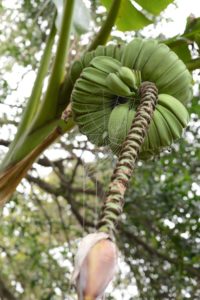
Once a banana tree makes a rack of bananas, the tree will die. So after harvest, cut the tree down so new ones will sprout!
From bugs to boredom, whatever the reason I’ll help you decide when it’s time to say GOODBYE with these 5 tips! But first….
Why do plants die?
A plant dies when too many intolerable factors overwhelm it’s ability to survive in an environment. This could be drought, disease, a bug infestation, or environmental decline.
Or, just like humans, all plants will succumb to old age at some point, if they don’t fall to disease or disaster first. Most garden veggies are plants called annuals. This means that the plant lives for a one year lifecycle (max).
Once old age sets in, a botanical process called senescence (Latin – to grow old), there is no saving the plant. This physiological process is programmed to start in at some point in every plant’s life depending on whether the plant is an annual, biennial, or perennial.
Annuals live 1 year max
Biennials live 2 years max
Perennials live a determined number of years for that particular plant (From 3 years to hundreds in the case of some tree species.)
Remember this, because it makes me so sad when people think they killed a plant (and that they don’t have green thumbs) just because senescence set in and they didn’t know their plant was an annual. If your plant dies, there is a good chance you did everything right and it was just old!
How to Know When It’s Time to GO!
5 tips for knowing when to pull out garden plants
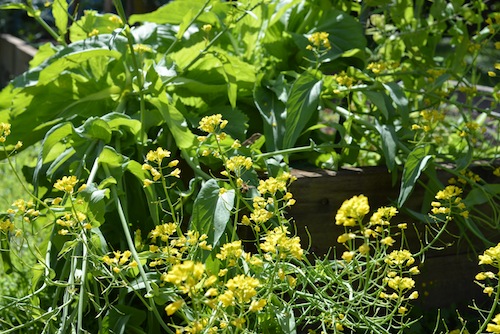
Here we have bolted broccoli plants with flowers and the start of seed pods. The brassica family is very easy to save seeds.
1. You’ve had a good harvest and the plant has gone to flower.
This applies to non-fruiting annual plants like greens and root veggies, and is called bolting. When kale and collard greens, spinach, broccoli, brussel sprouts, lettuces, carrots, beets, onions, radishes, bananas, cilantro, for example, go to flower it is time for them to go. Unless, of course, the plant is in good health and you are saving seed. Then, pull the plant after after you have harvested the seeds.
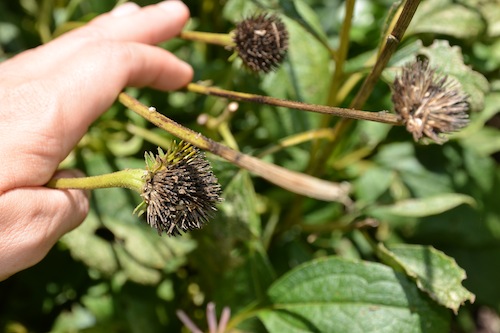
Echinacea is perennial, so harvest the seeds pods, cut back unhealthy leaves, then let the plant die back and return again next summer.
2. The plant has lost a lot of leaves and is declining in health for no observable reason.
If there hasn’t been a drought, you didn’t over fertilize, and you’ve had a good harvest and the season is changing, senescence has most likely set in. This process can take a number of weeks or even months in some cases. The best thing to do is pull the plant out and compost it before it declines in strength enough to attract (and is unable to defend itself against) harmful garden bugs and fungi to your garden.
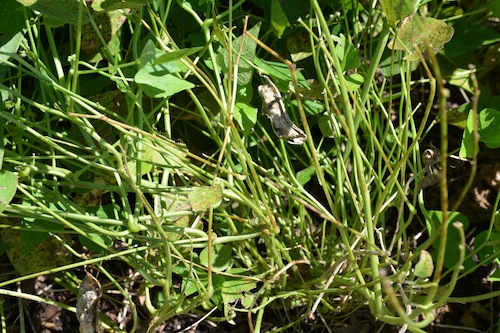
This bush bean plant looks like all sticks! Say goodbye, it’s time to go!!
3. The plant is covered in bugs.
If a plant is covered in bugs, and I mean covered, and you have treated it with organic insecticide, but can’t seem it get rid of the bugs, cut your losses and pull the plant. This plant was probably weak from the get go or maybe was even purchased with eggs. The plant is most likely too weak to save and you don’t want the bugs to spread to your other plants. Prevention is always the best medicine.
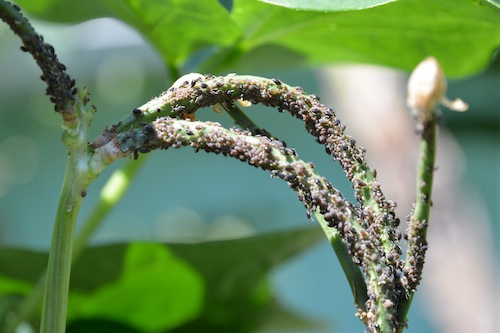
These black eye peas are covered in aphids. If I don’t get rid of them soon, they will weaken the plant and other bugs and diseases will move in.
4. The leaves are being eaten up and/or look generally unhealthy.
Unless you have a grasshopper or caterpillar infestation, this can be a tell tale sign of senescence. When a plant weakens and begins to die, insects and fungus begin to attack it. Leaf health is an initial indicator of plant decline. If your leaves look really unhealthy and you have tried feeding and organically treating the plant to no avail, pull it.
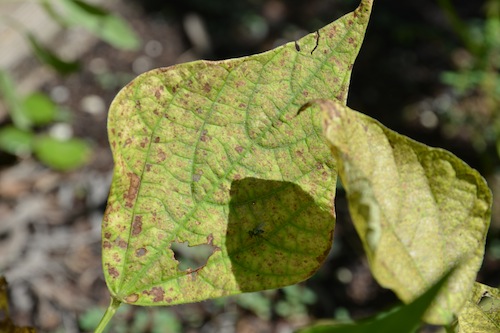
Unhealthy bush bean leaves. See the brown fungal spots and yellowing – and something is starting to eat the leaf.
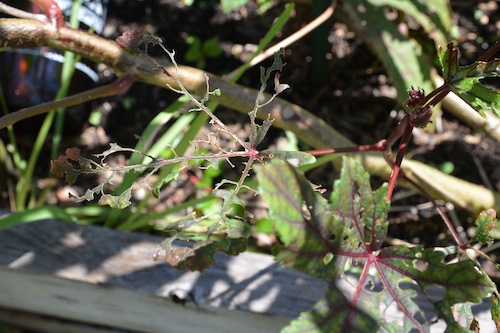
In this finished okra plant, some critter is skeletonizing the leaves.
5. It is well past the number of harvest days on the seed packet.
Seed packets tell you the number of days to harvest. Document when you planted your seeds and when you transplanted the seedlings into the garden. Then, do the math and figure how many days it’s been since transplant (or how many days it’s been since you planted your starts if you bought starts).
If this number is well past the number of days until harvest on the seed pack, whether you’ve had a big harvest or not, the plant isn’t really going to produce any more. Pull the plant before bugs or disease set in.
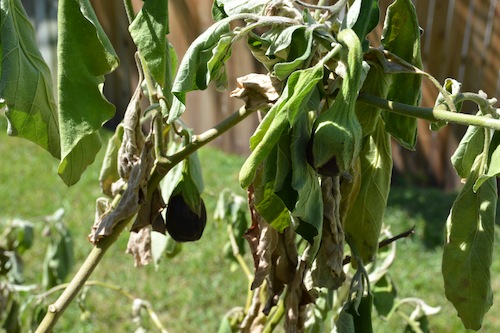
Fruits or no fruits, this eggplant is going no where but downhill. Pick the fruits and pull the plant.
For example: eggplants take 80 days from transplanting to harvest. If it has been 200 days, you’ve harvested plenty eggplant for a freezer full of baba ganouj, and the leaves are wilting, even if there are some flowers or a few small fruits on the plant, pull it. It is an annual and it’s life is ending.

Once you’ve harvested cabbage heads, the plant is done. Pull it.
As summer turns to fall in the garden, keep a close eye on your plants and be ready to pull out summer veggies in decline. I’ll say it again, prevention is the best medicine.
Clear out the old, make room for the new, and keep your garden healthy for a fall bounty!!
What signs of decline are you seeing in your garden this week?
What will you pull?
Share your garden transition experiences in the comments below & show us your garden pics on Instagram #wingswormsandwonder
Seeds to Sprout:
Wondering when to harvest? Check out this 3 post series on To Pick or Not To Pick!
Part 1: Knowing When to Harvest
Part 2: Factors out of our control, weather, bugs, and fungus
I am excited to announce that a facilitated session of my eCourse Draw Yourself Back to Nature starts October 19!! Learn more here! And get ready for some pre-course fun heading your way soon!!
From corn and cukes to beans and broccoli, sometimes we find bugs hiding inside our harvest! Learn about the CowPea cuculio and what to do about that black eye pea harvest rascal in this post Bugs in the Beans.
Comments are closed.
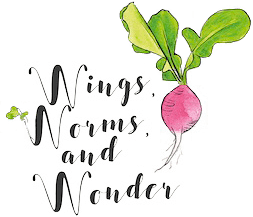
This is the best explanation for a beginning gardener on when go pull a plant! Thank you and it makes sense.
Dear Julie, I’m so glad you found it helpful! And many well wishes on your gardening adventure!